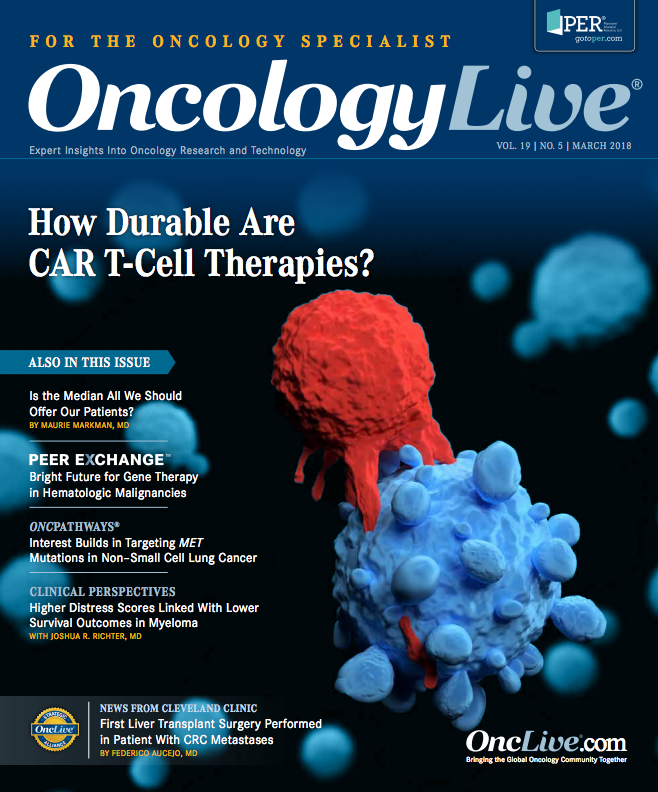Publication
Article
Novel Combo Explored for Rare Brain Tumor
Author(s):
Investigators are seeking to determine whether the combination of eflornithine with lomustine can improve survival for patients with recurrent anaplastic astrocytoma.
Emmanuel S. Antonarakis, MD, associate professor of oncology and urology at Johns Hopkins Medicine

Victor A. Levin, MD
Investigators are seeking to determine whether the combination of eflornithine (alphadifluoromethylornithine) with lomustine can improve survival for patients with recurrent anaplastic astrocytoma (AA). A rare form of brain tumor, AA occurs more often in adults aged 30 to 50 years and accounts for 17% of primary malignant brain tumors.1 This tumor type is even more rare when it recurs, according to Victor A. Levin, MD, emeritus professor of neurooncology at The University of Texas MD Anderson Cancer Center in Houston and a clinical professor at the University of California, San Francisco, School of Medicine.
Eflornithine is an irreversible inhibitor of ornithine decarboxylase, a key enzyme in polyamine biosynthesis; polyamines help create a chromatin environment that stimulates neoplastic transformation of cells. Inhibiting ornithine decarboxylase can affect DNA and mRNA stabilization, translation, and transcription, thereby inhibiting cell growth and proliferation.
According to Levin, eflornithine also has an inhibitory impact on cancer cells invading surrounding tissues and metastasizing to other sites, and it might even have an impact on the mutation rate of tumor cells. The drug can be taken multiple times daily because “the majority is excreted in the urine, unmetabolized,” he said. “Eflornithine is active alone as a single agent,” Levin said. “There is some experimental evidence that if it is given in combination with a nitrosourea, such as lomustine, then it can have additive activity, more than predicted from the single agent alone.”
Currently, treatment for patients with AA involves surgery for eligible patients (although these tumors are almost never cured with surgery2 ) followed by external beam radiation therapy (EBRT) with concurrent temozolomide (Temodar); EBRT combined with neoadjuvant or adjuvant procarbazine, lomustine, and vincristine (PCV); or EBRT alone. However, these treatments are often ineffective; the 5-year survival rate is 27%.2,3 “The only drugs we’ve had are drugs that alkylate DNA, either bifunctional cross-functioning DNA agents like nitrosoureas, or monofunctional agents like temozolomide and procarbazine. If this [combination with eflornithine] is successful and is subsequently approved, it will be the first new proven targeted therapy to get approved for the treatment of gliomas,” Levin said. “I believe that it will be critical, because it can effectively be used for lower-grade tumors and for pediatric patients.”
In the recurrent setting, treatment options are even more limited. The National Comprehensive Cancer Network guidelines suggest that eligible patients be enrolled in clinical trials, receive palliative care, or repeat systemic therapy, with lomustine being one of the options.3
The phase III randomized STELLAR trial (NCT02796261), which is currently enrolling, seeks to address the recurrent setting by adding eflornithine to lomustine compared with standardof-care lomustine monotherapy (FIGURE).
Figure. Eflornthine With Lomustine in Recurrent Anaplastic Astrocytoma
Eligible patients will have AA that recurred or progressed after completing radiation therapy and adjuvant temozolomide. Patients who received treatment for a grade 2 tumor who have recurrence of a grade 3 tumor will be included, as will patients who originally had a grade 3 tumor, provided it is their first recurrence. The primary endpoint is overall survival (OS).
Eflornithine has been under investigation for decades; the FDA has approved an intravenous form of the drug to treat patients with African trypanosomiasis, a type of sleeping sickness, and as a topical cream for the removal of unwanted facial hair in women. Early research demonstrated that it is active in both recurrent and newly diagnosed high-grade gliomas. One study compared eflornithine’s antitumor activity alone versus in combination with mitoguazone to treat patients with recurrent or progressive glioblastoma multiforme (GBM), as well as nonglioblastoma anaplastic gliomas.4 Out of a total of 80 patients (36 with GBM and 44 with anaplastic glioma), antitumor activity was seen in 45% of the patients with anaplastic gliomas for a median of 49 weeks, but in only 17% of patients with GBM.4
A later phase III randomized study was conducted comparing eflornithine combined with a regimen of PCV versus PCV alone in patients with anaplastic gliomas (n = 242). The combination arm (n = 114) had 78.1% of patients with AA, 3.5% with anaplastic oligoastrocytoma (AOA), 14% with anaplastic oligodendroglioma (AO), and 4.4% with other malignant gliomas. The PCV arm (n = 114) had 69.3% of patients with AA, 7% with AOA, 21.1% with AO, and 2.6% with other malignant gliomas.5 The combination demonstrated a benefit in PFS but not in the corresponding hazard ratios (HRs).
The addition of eflornithine led to a median PFS of 71.1 versus 37.5 months (P = .13) with PCV alone in patients with anaplastic gliomas and 56.2 versus 22.2 months (P = .18) in patients with AA. The authors of the study noted that there was a statistical significance in the survival advantage over the first 2 years of study (HR, 0.53; P = .02) but not after 2 years (HR, 1.06; P = .84), supporting their conclusion that eflornithine adds to the survival advantage of PCV chemotherapy for patients with anaplastic gliomas.5
In general, eflornithine is well tolerated. “The adverse events are the result of the fact that the drug is an osmotic load [an unabsorbable, water-soluble solute in the bowel that retains water through osmosis], so it’s a high dose of the drug, and as a result, there can be loose stools or diarrhea and, rarely, nausea,” Levin said. He also noted that in the STELLAR trial, patients are starting on a lower dose of lomustine, because the combination can cause anemia and low platelet counts.
Levin said he hopes that the combination can become a new standard-of-care regimen for patients with AA. “This is a very rare condition, and the sooner we can get patients recruited on the study, the sooner we will be able to make it available for the treatment of all glial tumors,” he said. Eflornithine is being developed by Orbus Therapeutics, based in Palo Alto, California.









